MXA RACE TEST: 2017 HUSQVARNA FC450: REWARD FOR A LIFE WELL SPENT
Click on images to enlarge
Q: FIRST AND FOREMOST, IS THE 2017 HUSQVARNA FC450 BETTER THAN THE 2016 FC450?
A: Yes, but whether it’s worth $9000 to upgrade to the newer model depends on how much work you put into your 2016 FC450.
Q: WHO NEEDS TO BUY A 2017 HUSQVARNA FC450?
A: Here’s a quick list of potential customers for the 2017 Husqvarna FC450.
(1) Prime customers. If you own an older-model (2016 or earlier) CRF450, KX450F, YZ450F or RM-Z450, then you owe it to yourself to consider buying the Swedish/Italian/Austrian orphan bike. Why? It weighs as much as 17 pounds less than your current bike, makes 4 more horsepower, handles amazingly well, has brakes to die for, offers a self-adjusting hydraulic clutch and starts with the push of a button. Did we mention that it weighs 224 pounds? That’s less than some 250Fs.
(2) Return customers. If you own a 2015-or-older-model 450SXF or FC450, then you already know what the experience is like. Take our word for it, Husqvarna has dropped 10 pounds since 2015, beefed up the ponies, flattened the chassis and fixed the awful forks for 2017. You deserve a new bike, because you supported the local Mattighofen merchants when they were not so universally loved. Take a bow and reward yourself with a 2017 Husky.
(3) Forty-year-old rich guys. Once when he was in a product management meeting with the Austrian brass, KTM and Husky’s product planners asked Jody Weisel who he thought the typical KTM 450SXF buyer was. Jody said, “A 40-year-old rich guy.” The KTM engineers laughed and then sent someone scurrying to the marketing department to get the actual numbers. Surprise! It was a 40-year-old, college-educated, family man with 2.5 children. Why is this? Because these guys have worked their whole lives to raise a family, pay off the house and send the kids to college. Now they want to reward themselves for a job well done by buying the bike they couldn’t afford when they were 18 years old.
 The 2017 Husqvarna FC450 may be the blood brother of the KTM 450SXF, but it feels more compliant, handles better and has a kinder, gentler powerband.
The 2017 Husqvarna FC450 may be the blood brother of the KTM 450SXF, but it feels more compliant, handles better and has a kinder, gentler powerband.
Q: DOES A 2016 HUSQVARNA FC450 OWNER NEED TO BUY A 2017 FC450?
A: Heavens to Murgatroyd, no! If you have a perfectly good 2016 KTM or Husky 450 in your garage, you already own 95 percent of the 2017 model. That means you have the exact same frame, engine, fuel injection, swingarm, wheels, ergonomics, brakes, clutch, levers, footpegs, transmission, airbox, exhaust, handlebars, grips, dual maps, launch control and bodywork as the 2017.
What you don’t have are the AER air forks, the 4.5 N/m shock spring, longer brake pedal, multi-switch controller, handlebar clamps, less aggressive brake pads and stiffer top triple clamp.
Q: CAN A 2016 FC450 OWNER DUPLICATE THE 2017 FC450 WITH AFTERMARKET PARTS?
A: Yes. Let’s go through the shiny new baubles that make a 2017 Husky FC450 different from a 2016 FC450 and see if you can match them.
(1) Air forks. Beyond a shadow of a doubt, the 2017 WP AER air forks are titanically better than the 2016 4CS forks. That said, you have several options available: (a) You can have your 4CS forks re-valved by ESR, FTI, Race Tech, Works Performance, Too Tech, MX1, Pro Circuit or MX-Tech. They all do an excellent job of making the 4CS forks more fluid for individual tastes. (b) We had TBT put Kayaba PS-2 air-fork internals in our 2016 Husqvarna FC250 and they work like a charm ($1000). TBT can also install Yamaha Kayaba coil-spring SSS internals in the 4CS fork for $1500. (c) WP Factory will sell you a brand-new set of AER air forks for $1800. (d) If you are a high-roller, you can get WP’s A-Kit-style Cone Valve forks for $3400. It’s the fork that most serious KTM racers run. We admit that there is a price tag associated with these mods, but they are a lot cheaper than $9499 for a new bike.
(2) Shock spring. Last year the 2016 Husky FC450 came with a 48 N/m shock spring. The 2017 FC450 will have a 45 N/m spring. If you weigh over 200 pounds, you wouldn’t want the 45 N/m spring anyway. And, if you are in the target 175-pound weight range, you can get a 4.5 N/m spring from any suspension shop for just over $100.
(3) Triple clamp. The 2017 top triple clamp is more rigid than it was in 2016. But, this isn’t a deal-breaker for anyone short of a factory rider or a professional test rider. Plus, only the top triple clamp is different, not the complete set. Thus, you could order a beefier top clamp from Applied or Ride Engineering and get stronger bar mounts in the process.
 This multi-switch allows the racer to trigger between two maps, launch control and traction control. We always run map #2, rarely use traction control and only use launch control on concrete or hard-pack starting lines.
This multi-switch allows the racer to trigger between two maps, launch control and traction control. We always run map #2, rarely use traction control and only use launch control on concrete or hard-pack starting lines.
(4) Map switch. The 2017 Husky has a fancy-dancy electronic multi-switch with flashing lights to control map selection and launch control. The 2016 Husqvarna FC450 map switch was an economical, low-tech, flick-style selector switch. Guess what? They both do the same thing, plus the flick switch can access three different maps, while the whiz-bang multi-switch only accesses two.
(5) Traction control. Let’s not get too misty about the addition of traction control to the 2017 FC450’s electronic ensemble. It’s not all it’s cracked up to be. We would never use it on loam, prepped dirt or sand. It’s only practical on dry hardpack or full mud. In practice, the traction control feature on the 2017 model is basically the mellow map that is already on the 2016 FC450.
(6) Brake pedal. The 2017 rear brake pedal is now 10mm longer than it was in 2016. Owners of 2016s can order a 10mm-long brake tip from 7602 Racing that does the same thing (only in anoduzed colors). The retail price is $34.95 at www.7602racing.com.
(7) Rear brake pads. For 2017 the rear brake pads have a less aggressive compound. Why? Many racers felt that the previous rear brake pad was too grabby and could overheat if used too aggressively. Not everyone agreed, but if you do, you can fit the 2017 pads in your 2016 the next time you need new pads.
(8) Head stays. Last year’s steel head stays have been replaced with cast-aluminum stays that are 60 grams lighter than the steel they replaced. There are 28 grams in an ounce, so we are talking about a hair over 2 ounces. But if it bothers you, they will retrofit on your 2016.
(9) Hour meter. There is an hour meter installed on every 2017 Husqvarna FC450 at the factory. Nice touch, but hardly worth nine large.
(10) DDS clutch. KTM increased the oil flow inside the 2017’s CNC-machined, Damped Diaphragm Steel clutch basket and pressure plate. Face it, Husky’s hydraulic clutch is so much better than anything that comes on an RM-Z, CRF, YZ-F or KX-F that it would be like cheating if you got your 2016 clutch to feel 0.5 percent better over the long haul.
 The big changes for 2017 are the air forks, lighter shock spring, more rigid top clamp, longer brake pedal, thicker head stays and an all-new electronics ensemble.
The big changes for 2017 are the air forks, lighter shock spring, more rigid top clamp, longer brake pedal, thicker head stays and an all-new electronics ensemble.
Q: WHAT’S IT LIKE TO RACE THE 2017 HUSQVARNA FC450?
A: There is no hiding the fact that the 2017 Husqvarna FC450 is a gussied-up KTM 450SXF. But, you have to wonder, what’s really going on behind the scenes? Is the KTM 450SXF the ultimate expression of 450 motocross tech, or is the Husqvarna FC450 one step up the ladder? Which came first, the chicken or the egg? We are never going to get an answer from the Austrians. They want to make consumers think that the Husqvarna FC450 is something unique, cool and oh-so-precious. They don’t really want the consumer to connect the dots and realize that the Husqvarna is the country-bumpkin cousin of the KTM 450SXF.
Platform sharing is a shell game. The 2017 KTM 450SXF and 2017 Husqvarna FC450 are not all that different from the 2017 Mazda Miata MX5 and the 2017 Fiat 124 Spider. One is Italian and one is Japanese, right? The sheet metal looks different on the two roadsters, but inside the door jams of both are placards that read “Manufactured by Mazda Motor Corporation.” It’s no secret that the Husqvarna FC450 starts with the bones of the KTM 450SXF. But, it is also no secret that if you are going to share a platform with a competitor, you couldn’t do better than a KTM donor. The goal for Fiat and Husqvarna is to take the loaner parts and succeed in creating an end product with its own unique character. If the Husky can’t be differentiated from the KTM, then the pea is under shell number three.
So how did Husqvarna do in the shell game? Pretty well. We would have expected that this far down the road in their partnership Husqvarna would have gotten some defining flagship to solidify its individuality, like a Husqvarna FC400 instead of just another clone of the KTM 350SXF. But, while the internals of the two products may be identical, the end result does have some uniqueness to it.
Compared to the KTM 450SXF, the FC450 has a more mannerly powerband. The Husqvarna’s power delivery is easier to manage than the output of its orange cousin. That doesn’t mean that the 2017 Husky FC450 is slow; it’s just not a rompin’, stompin’ thrill ride. It is, for lack of a better phrase, a friendly 450. It has a metered pull, while the KTM 450SXF is snappier, more responsive and quicker from low-to-mid.
The Husky’s pleasant low-to-mid transition becomes stronger as the rpm climb, but it doesn’t have the gun-and-run surge that the KTM 450SXF and Yamaha YZ450F exhibit, which makes it a smoother and more effortless bike to ride. If, in fact, the restrictive nature of the plastic airbox is what makes the power feel more cultured, that could be a good thing or a bad thing depending on your riding style.
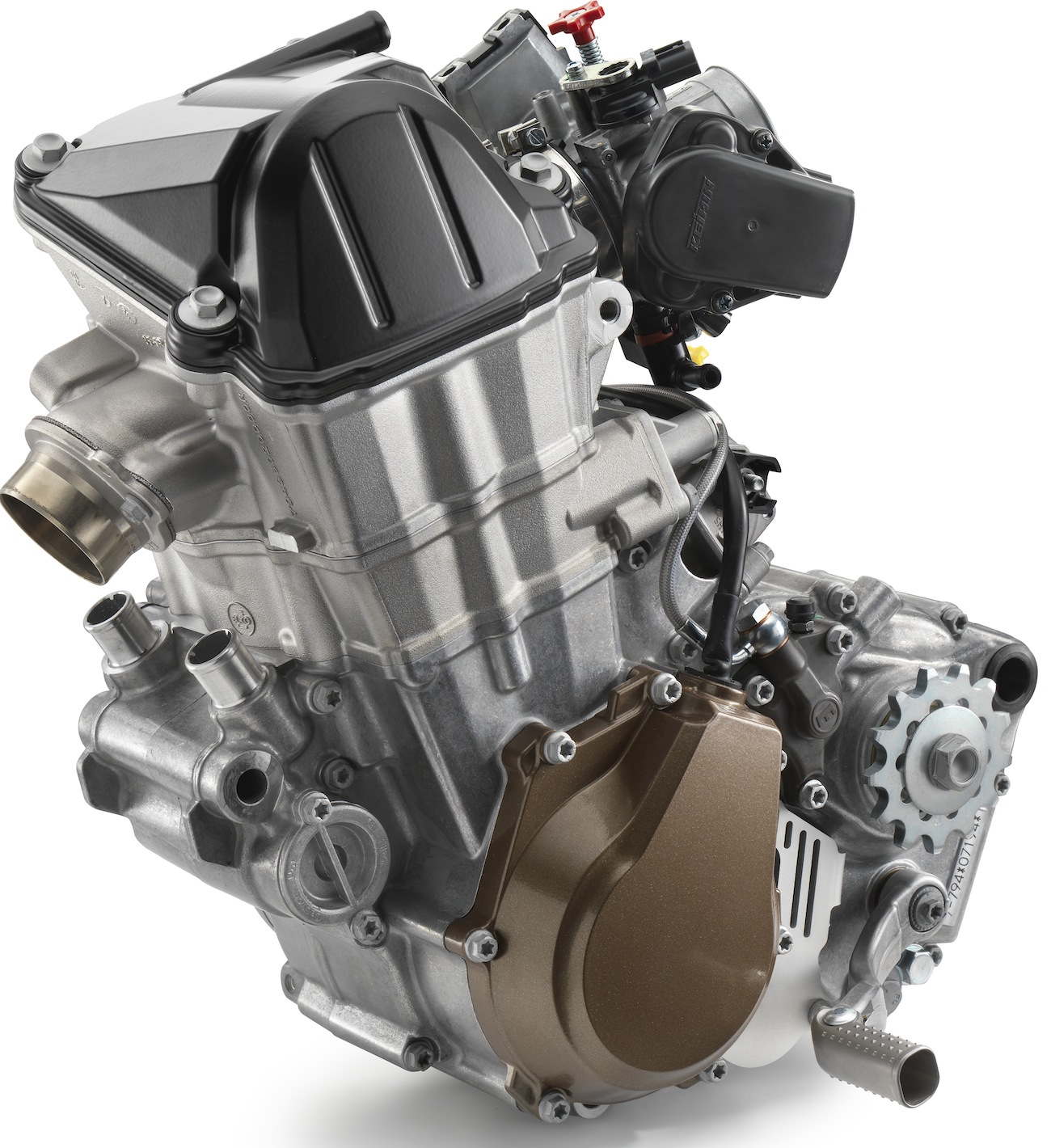 This is a KTM engine disquised as a Husqvarna engine with anodized covers. Don’t sweat it because if it had to be somebody else’s engine, you’d want it to be KTMs.
This is a KTM engine disquised as a Husqvarna engine with anodized covers. Don’t sweat it because if it had to be somebody else’s engine, you’d want it to be KTMs.
Q: HOW DOES THE 2017 HUSQVARNA FC450 RUN ON THE DYNO?
A: The 2017 Husqvarna FC450 makes 57.10 horsepower at peak (9300 rpm), which is just 0.78 horses less than the class-leading KTM 450SXF. Don’t sniff at that number, because the Husky makes more power than the YZ450F, KX450F, CRF450 and RM-Z450.
Q: HOW DOES THE 2017 HUSQVARNA FC450 HANDLE?
A: The obvious answer would be, “Like a KTM 450SXF.” But, for some unknown reason, every MXA test rider preferred the way the Husqvarna chassis felt in motion over its Mattighofen stablemate. Logically, we can only draw the conclusion that this pleasant sensation is because of the resilient subframe and mellower powerband. It is only supposition, but we think the combination of more give in the chassis and less load on the drivetrain gives the Husky more pleasant ride characteristics.
The KTM and the Husky have the best all-around handling to any bike on the track in 2017. They are almost intuitive. Test riders never need to muscle the bike into a corner, or countersteer out. Touch it with your knee and prod it with the throttle and you are through the tightest switchbacks without breaking a sweat. This is a great chassis.
From a numbers point of view, the KTM 450SXF and Husqvarna FC450 roll down the same assembly line and share identical geometry, wheelbase, weight bias and components. Numbers aside, though, every test rider came to the conclusion that he liked the Husky’s handling better than the KTM’s. But, universally they liked the KTM engine more than the Husqvarna for pure racing — however, with a muffler, drill and a few simple mods you can make the Husqvarna engine run identical to the KTM 450SXF engine.
Q: WHAT DID WE HATE?
A: The hate list:
(1) Spacers. There are spacers in the seat-bolt hole and right-side panel that fall out when you remove either of these two bolts. Shouldered bolts or tolerance-fit spacers would have solved this problem. We used grip glue.
(2) Exhaust. You can’t take the pipe off the bike without removing the shock. We recommend dynamite.
(3) Sprocket/spokes. Watch the sprocket bolts closely. They loosen up constantly. On the plus side, we had better luck with the spokes in the rear wheel of the Husqvarna than the KTM. We credit this to the D.I.D. rim on the FC450.
(4) Front brake hose. Be very careful when hooking tie-downs onto your handlebars that they don’t crimp the L-bend tube coming out of the front brake’s master cylinder. We would prefer more room between the brake line and the bars to lessen the chance of damage.
(5) Tiny Torx. Although the left-side panel pops off without any tools, the right-side panel requires a #20 Torx wrench. Plus, you’ll need the #20 to bleed the forks. To make matters worse, the clutch-side ODI lock-on grip can only be removed with a #15 Torx wrench.
(6) Heat shield. We had to double up the heat shield on the side panel to stop the pipe from melting through the side panel.
(7) Muffler core. Unlike the flow-through KTM muffler, the Husky FC450 muffler core has ice-cream-cone-shaped perf-core cones welded in to reduce sound and low-end power. This muffler was on KTMs four years ago, but KTM got rid of it because it hurt the bottom-end power. It still does.
(8) Gearing. You can drill the airbox and get rid of the ice-cream cones to make the FC450 more responsive, but the best all-around fix is to gear it down one tooth.
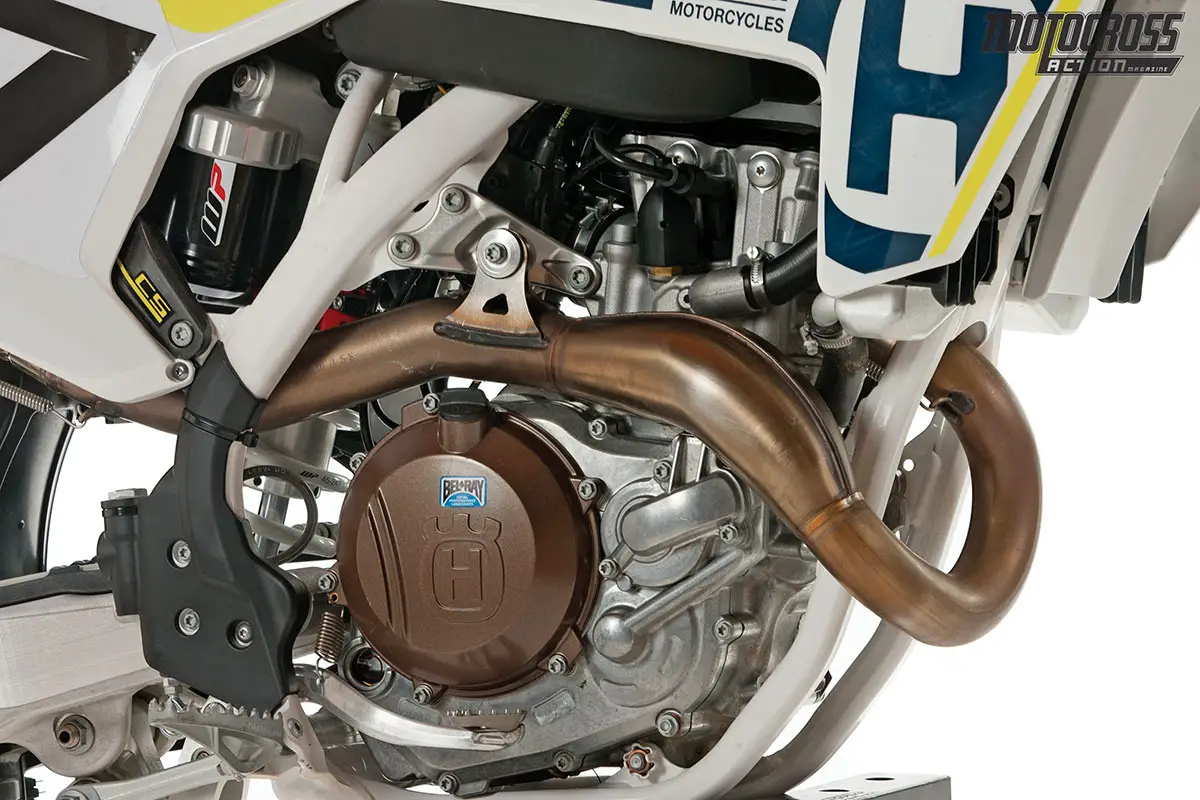 Husqvarna’s version of the KTM 450SXF engine is hampered by a restrictive airbox and plugged-up muffler.
Husqvarna’s version of the KTM 450SXF engine is hampered by a restrictive airbox and plugged-up muffler.
Q: WHAT DID WE LIKE?
A: The like list:
(1) Weight. At 224 pounds, the Husqvarna weighs 2 pounds more than the KTM 450SXF. The source of the added pounds is the three-piece plastic airbox, ice-cream-cone perf core and heavier GFK brake rotors.
(2) Tires. Last year the Husqvarna FC450 had Dunlop MX52 tires. This year, it has MX3S tires. We preferred the MX3S tires on prepped dirt.
(3) Electronics package. The new multi-switch gives the rider the choice of two maps (we always ran the aggressive map), launch control (which we only used on concrete or hardpack) and traction control (which we used in place of last year’s mellow map).
(4) Air filter. After years of having to wrestle big filters through small holes, we finally get a break. The new KTM/Husqvarna air-filter design is brilliant.
(5) AER forks. It’s nice to be able to say that the Husqvarna FC450 has the best air forks on the track, with the caveat that its cousin has the same forks.
(6) Powerband. If you want more horsepower, you can get it with a drill.
(7) Brakes. Better than anything on the Honda, Yamaha, Kawasaki or Suzuki.
(8) Hydraulic clutch. Us eit all you want it won’t fade
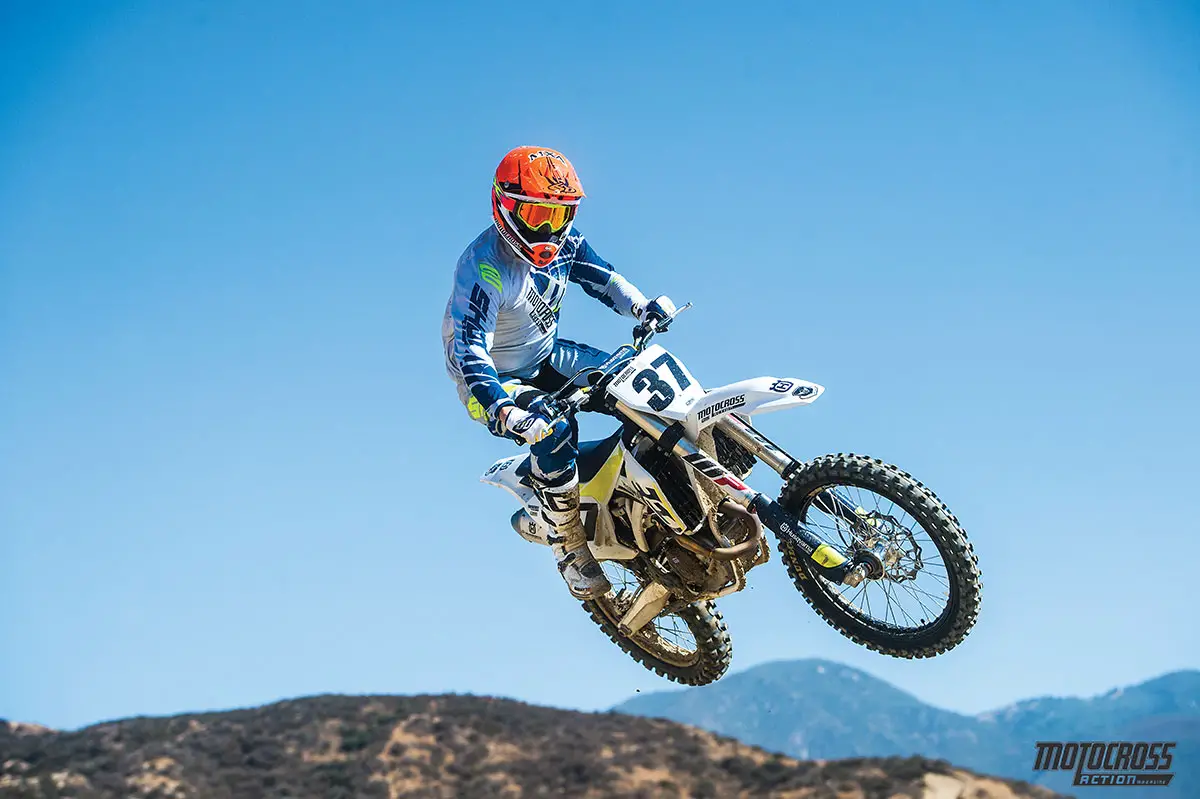 Blessed with great air forks, excellent Dunlop MX3S tires and awesome brakes, the front of the FC450 is a winner.
Blessed with great air forks, excellent Dunlop MX3S tires and awesome brakes, the front of the FC450 is a winner.
Q: WHAT DO WE REALLY THINK?
A: Platform sharing allowed KTM to jump-start the revival of the Husqvarna brand in time to have bikes available for its inaugural 2014 selling season. Platform sharing was not just an R&D shortcut; it expedited the dealer network, parts supply and technical support for what was essentially a start-up brand four years ago. If Husqvarnas were little more than white KTMs, there would be no reason to buy one, since white plastic is already available for KTMs. Husqvarna’s success is not ensured by its nostalgic name or iconic gun-sight logo; Husqvarna has to make a name for itself as a worthy adversary for the bike whose parts it has borrowed. The 2017 Husqvarna FC450 has taken baby steps towards developing its own character. It is a very good bike, especially for people who vowed years ago that they would never ride a KTM. Hower, while it is different from a KTM, it is not different enough to delineate from its closest relative.
MXA’S HUSQVARNA FC450 SETUP SPECS

This is how we set up our 2017 Husqvarna FC450 for racing. We offer it as a guide to help you find your own sweet spot.
AER FORK SETTINGS
The trick to getting the most from your AER air forks is to find the proper air pressure for your weight, speed and track. We typically start with the OEM-recommended air pressure and then lower it in 2-psi increments. How do we know when we have the proper pressure? We lower the air pressure to the point where the forks don’t feel like they are dropping into their stroke without bottoming. Typically, they ride high in their stroke with the stock pressure. For the average Husqvarna buyer, the best pressures will be found between 135 psi and 145 psi. Once you find the proper air pressure for your weight, speed and track, stick with it. Turn you attention to the clickers on the right fork leg to dial the forks in. For hardcore racing, we recommend this fork setup on the 2017 Husqvarna FC450 (stock specs are in parentheses):
Spring rate: 140 psi (156 psi)
Compression: 15 clicks out
Rebound: 15 clicks out
Fork-leg height: Third line
Notes: Don’t get to discourage if the forks feel stiff at the stock air pressure (156 psi), because most riders don’t like that much air. We have test riders who have gone as low as 130 psi, but rarely does anyone go above 150 psi. Slower or lighter riders might even have to lower the oil height in the damping leg by 10cc or more to get full travel. Additionally, the air pressure in the forks will change when the ambient temperature goes up or after riding a long moto. You may need to bleed off excess air pressure, but its best to let the forks cool first. We do bleed the outer chamber constantly, which is accessed via a 10mm hex head or #20 Torx. Even if you own a #20 Torx, don’t use it, because it strips out easily. The right leg’s air-bleed screw can only be opened up with a #20 Torx, but at least it’s made out of steel. We put last year’s Phillips-head air-bleed screw in the right fork cap.
WP SHOCK SETTINGS
Last year the Husqvarna FC450 came with a very stiff 48 N/m shock spring. Many riders had trouble getting any preload on the shock spring. MXA swapped all of its 48 N/m springs for lighter 45 N/m springs. For 2017 Husky is lowering all of its motocross bike spring rates, which means that the 2017 FC450 will have a 45 N/m spring stock. If you are around 200 pounds, you will probably want to return to the 48 N/m spring. For hardcore racing we recommend this shock setup for the 2017 Husqvarna FC450 (stock specs are in parentheses):
Spring rate: 45 N/m
Race sag: 105mm (110mm)
Hi-compression: 1-3/4 turns out (2 turns out)
Lo-compression: 20 clicks out (15 clicks out)
Rebound: 10 clicks out (15 clicks out)
Notes: We turned the high-speed compression damping in a little to lessen G-outs and ran a touch more rebound than the recommended setting. Additionally, we set the sag at 105mm instead of the WP-recommended 110mm. If you weigh 200 pounds, put last year’s 48 N/m spring on the bike.


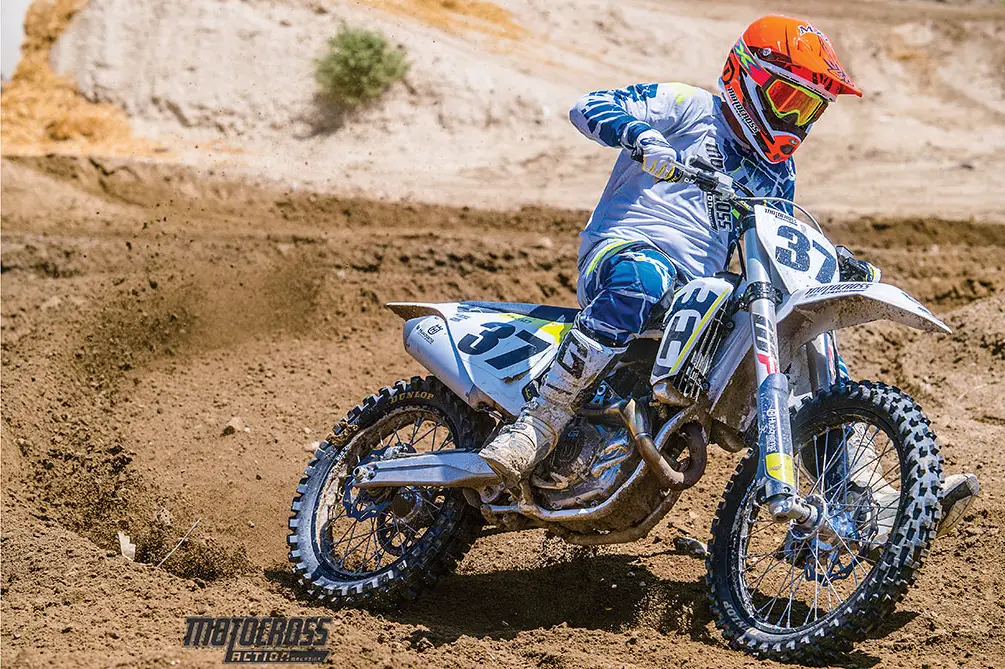
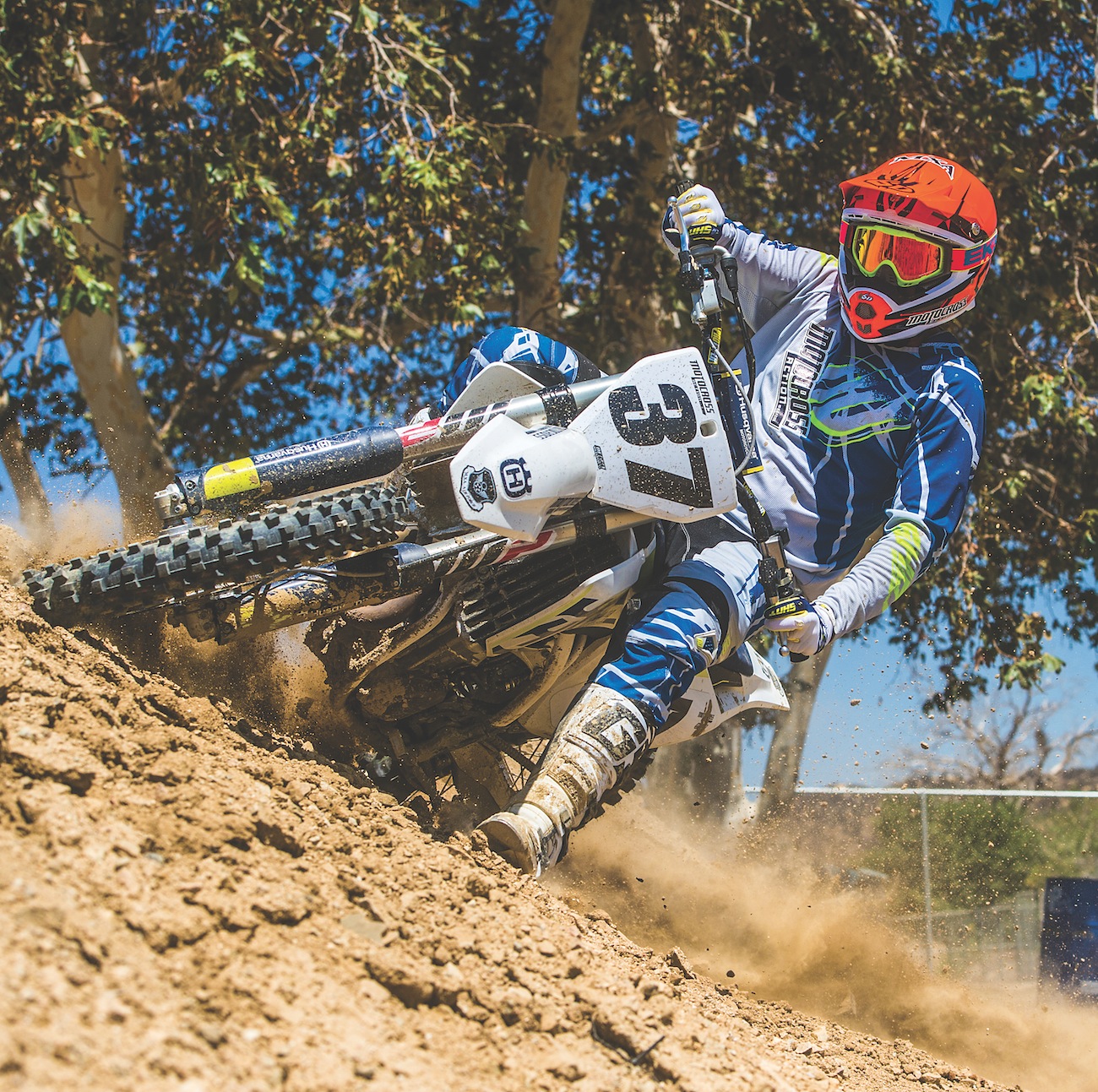

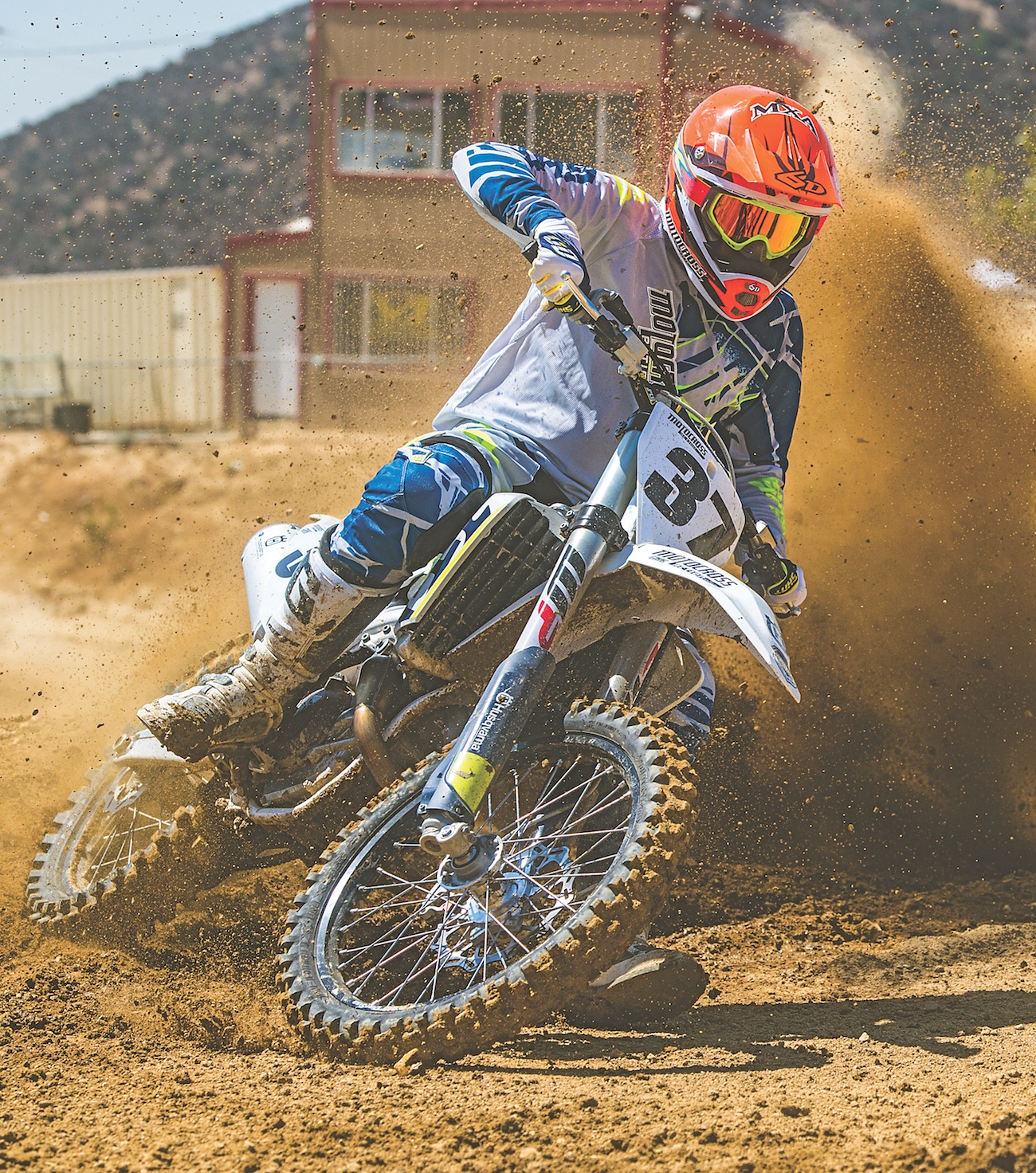



Comments are closed.